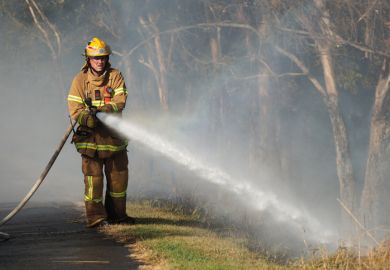The Australian National University has closed for the second time in a month, as a summer of extremes wreaks disruption and destruction on the country’s higher education and research infrastructure.
ANU staff were told to take shelter on the afternoon of 20 January as the main campus in Canberra was rocked by a ferocious storm. Hailstones reportedly as big as golf balls were known to have damaged “a large number of buildings”, the university said.
The campus remained closed to all but essential workers on 21 January as assessments were conducted. On-campus residents have been allowed to stay but warned to steer clear of water and debris.
Others have been asked to keep away unless visits are essential, a website says, acknowledging that “some of you may need to come on campus to make arrangements for damaged vehicles”.
Research facilities have also been devastated elsewhere in Canberra, with the Commonwealth Scientific and Industrial Research Organisation sustaining damage to scores of glasshouses hosting long-term research projects on crop sustainability.
CSIRO chief operating officer Judi Zielke told the ABC that most of the work had been lost. “For projects that might have been close to the end of two or three years’ work, that is really distressing,” she said.
The ANU closure comes less than three weeks after the campus was shuttered for six days by hazardous smoke from nearby bushfires, as a global index reportedly rated Canberra’s air quality as the worst of any major city in the world.
Staff were told to extend their new year holidays on full pay, with the smog-choked campus closed as a precautionary measure. Even after it reopened on 8 January, people were encouraged to work from home because of power outages.
“I know that disruptions have created challenges, and I ask for your continued patience as we work to return our campus to normal,” vice-chancellor Brian Schmidt told staff and students, while imploring them to remain mindful of the factors underpinning fires that ranked “among the most devastating in Australia’s history”.
“We all have a part to play in keeping these issues front of mind,” he said. “This is a linchpin moment in our history, and what we do now will not only define generations to come, it will set the course for how the world addresses climate change.”
Meanwhile, ANU air pollution expert Sotiris Vardoulakis published a series of factsheets on the risks of bushfire smoke and how to avoid them. Professor Vardoulakis said existing advice was mainly tailored to brief episodes lasting one or two days.
He said the factsheets were designed for people and communities wondering how to plan daily life now and in the future. “In the current bushfire season, urban centres have been exposed to high levels of smoke over weeks and months,” he added.
Register to continue
Why register?
- Registration is free and only takes a moment
- Once registered, you can read 3 articles a month
- Sign up for our newsletter
Subscribe
Or subscribe for unlimited access to:
- Unlimited access to news, views, insights & reviews
- Digital editions
- Digital access to THE’s university and college rankings analysis
Already registered or a current subscriber?










